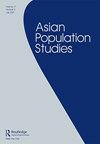中国少数民族流动人口的族群网络与跨省流动目的地选择
IF 1.5
4区 社会学
Q2 DEMOGRAPHY
引用次数: 1
摘要
摘要以往的研究表明,共族网络是解释少数民族移民集中分布格局的重要因素。本研究利用全国流动人口动态监测调查的汇总数据,考察了共同民族网络在中国少数民族省际迁移目的地选择中的作用,以及教育如何调节这种作用。条件logit模型显示,除满族外,少数民族移民更有可能前往具有较大共同民族网络的省份。共同民族网络规模的影响也存在群体差异,其中藏族和侗族比研究中其他少数民族的影响更大。研究进一步发现,较高的教育水平降低了共同民族网络对西藏和朝鲜移民目的地选择的影响。对于研究中的其他少数民族群体,教育的调节作用要么是积极的,要么是不显著的。本文章由计算机程序翻译,如有差异,请以英文原文为准。
Co-ethnic networks and inter-provincial migration destination choice of ethnic minority migrants in China
ABSTRACT Previous research shows that co-ethnic networks are an important factor in explaining the concentrated pattern of distribution of ethnic minority migrants. This study uses pooled data from the National Migrant Dynamics Monitoring Survey, to examine the role co-ethnic networks play in ethnic minorities’ inter-provincial migration destination choices and how it is moderated by education in China. Conditional logit models reveal that except for Manchus, ethnic minority migrants are more likely to go to provinces with large co-ethnic networks. There are also group differences in the effect of co-ethnic network size, with it being greater for Tibetans and Dong than for the rest of minority groups in the study. It is further found that higher levels of education reduce the effect of co-ethnic networks on Tibetan and Korean migrants’ destination choice. For the rest of the ethnic minority groups in the study, education’s moderating effect is either positive or not statistically significant.
求助全文
通过发布文献求助,成功后即可免费获取论文全文。
去求助
来源期刊

Asian Population Studies
DEMOGRAPHY-
CiteScore
3.30
自引率
14.30%
发文量
12
期刊介绍:
The first international population journal to focus exclusively on population issues in Asia, Asian Population Studies publishes original research on matters related to population in this large, complex and rapidly changing region, and welcomes substantive empirical analyses, theoretical works, applied research, and contributions to methodology.
 求助内容:
求助内容: 应助结果提醒方式:
应助结果提醒方式:


